|
Five Star Camera Co. Five Star |
Manufactured or assembled in USA from (Circa) 1946 to (After) 1946.
Index of rarity in France: Rare (among non-specialized garage sales)
Inventory number: 6308
See the complete technical specifications
Chronology of cameras Five Star Camera Co.
A Candid Type is defined by its use. Breaking with most previous models, these are cameras allowing spontaneous shooting. We can say that it can be applied to a multitude of cameras. Of course, we can draw some characteristics or constraints from it such as the small size for discretion, the use in natural light for spontaneity, the flash capturing the attention of the subject photographed beyond the first trigger. You also have to know how to accept some faults such as the lack of sharpness, the grain, the use of black and white. If these defects quickly disappeared thanks to an improvement in the quality of cameras and films, in the 1930s, it is still a reality.
Admittedly, a Leica can be assimilated to a Candid Type, but it is in the simplest that Galter is interested, pushing the notion of low end to its maximum. The term minimum is certainly more appropriate in the present case.
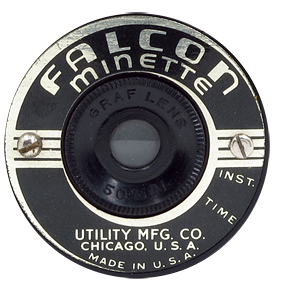 The cameras manufactured by Galter use the 127 film and give most of the time 3 x 4 cm negatives. They are sometimes made of bakelite, often of another plastic material with poor heat resistance. Moreover, we find many of his cameras with deformations without knowing if they presented them from the manufacture or if exposure to the sun is responsible.
The cameras manufactured by Galter use the 127 film and give most of the time 3 x 4 cm negatives. They are sometimes made of bakelite, often of another plastic material with poor heat resistance. Moreover, we find many of his cameras with deformations without knowing if they presented them from the manufacture or if exposure to the sun is responsible.
The front face is covered with a round plate, held by two screws. If they are removed, the whole lens and shutter assembly comes apart. Inside, depending on the type of mould used, there may or may not be a housing for a replacement film.
Around the front lens are the name of the lens, Graf, and the 50mm focal length. The plate is generally decorated with two metallic circles: one closest to the lens, the other at the edge of the plate. The name of the pseudo-brand is inscribed under the lens, horizontally, followed by the indication of the city of manufacture, then a “Made in U.S.A.” on the curve.
The typography is often of the same inspiration.
The shutter is without cocking. Speeds are indicated by INST. and TIME.
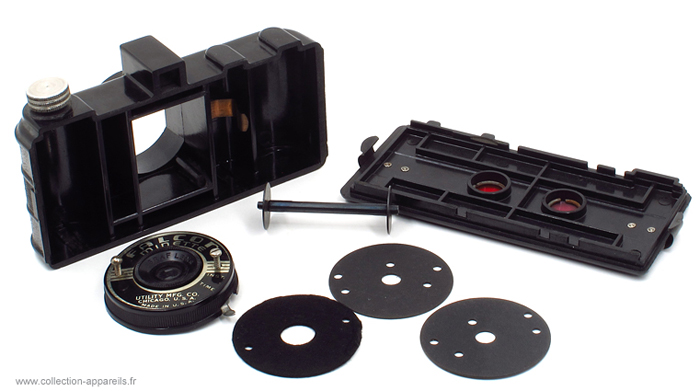
To manufacture a Galter camera, you have to mould the back, the front part and the shutter cover separately. In the rear part, the two inactinic windows are inserted and the two closing claws are riveted. On the largest piece fits the film advance wheel. Inside, a metal lamella holding the film in place is riveted. The element constituting the lens is inserted in the Bakelite part of the shutter. The latter is slid into the front part. Its rear face is roughly cut from thin sheet metal and bent as required. It is hidden by a felt washer, then strong cardboard wedges are installed between this block and the front part of the camera to correct the focal length. The front plate is installed, and two screws hold it all together. All you have to do is insert a spool axis, and too bad if the assembly was approximate. The assembly is very fast and does not require any technical qualification.
The cameras, despite a multitude of (fake) brand names are grouped into a few types, which results from a limited number of moulds. Some atypical cameras result from the integration of other manufacturers. Variations, based on these moulds, can have a different closure system or screws holding the coil above the protrusions.
The decorations on the front of the body may vary: horizontal lines in variable number,
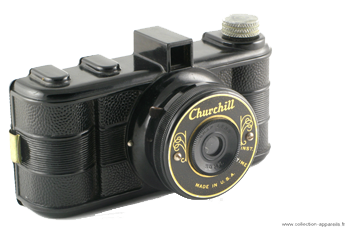 Long-shaped mould, with two protrusions on the cover and thickened ends, made of Bakelite Long-shaped mould, with two protrusions on the cover and thickened ends, made of Bakelite |
Long-shaped mould, but without a second protrusion. In plastic material.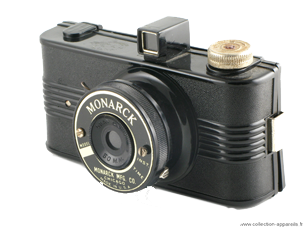 |
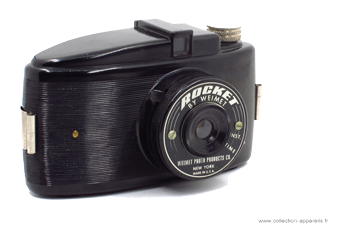 Plump shape Plump shape |
Short form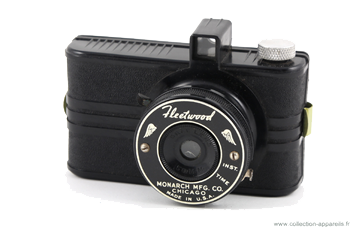 |
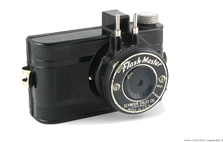 With pins for flash With pins for flash |
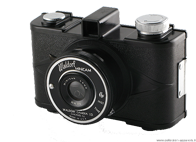 Short shape with protrusion Short shape with protrusion |
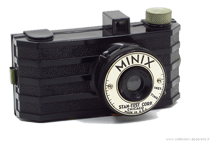 Angular mould Angular mould |
Asymmetrical shape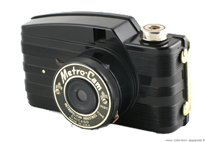 |
 shape... artistic shape... artistic |
|
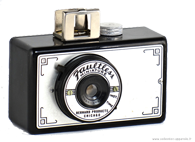 Horizontal shape. Made of bakelite Horizontal shape. Made of bakelite |
Long shape, with folding viewfinder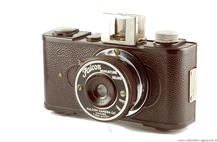 |
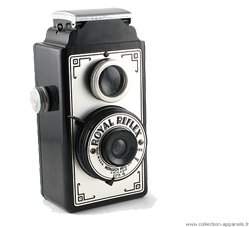 Vertical design imitating a TLR. Made of Bakelite or metal Vertical design imitating a TLR. Made of Bakelite or metal |
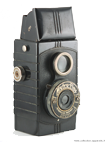 Vertical design imitating a TLR. Made of Bakelite Vertical design imitating a TLR. Made of Bakelite |
Cette marque n'a qu'un seul modèle à son actif, celui-ci étant éponyme.
Nous sommes en plein dans la nébuleuse de Chicago, qui sous couvert de nombreuses marques factices, distribua de nombreux modèles d'appareils aux grandes similarités. Ces modèles se répartissent en quelques grands types. Ce Five Stars appartient à un type où le haut du corps de l'appareil est courbé. Le fût de l'objectif, la plaque autour de l'objectif, les deux vis sont autant de traits communs. L'objectif n'est pas marqué "Graf" comme souvent sur ce type d'appareils.

Interesting links or bibliography :
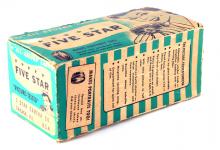 |
Add a link or element of bibliography, a picture taken with this camera, a picture of box or an ads about this camera
Your photos taken with the same camera:
Cameras from Ebay France (Five Star Camera Co.) (Uploaded each 3 hours)








